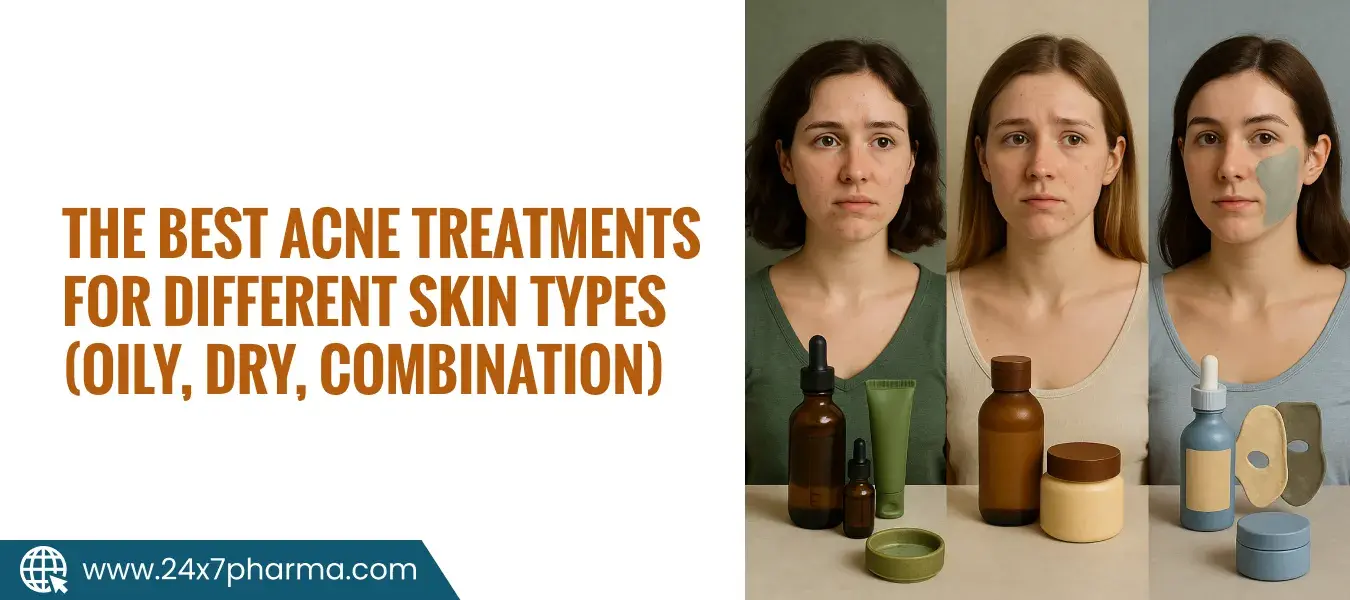Introduction
Acne is a prevalent skin concern that affects individuals across all skin types. However, the optimal treatment varies depending on whether your skin is oily, dry, or combination. Understanding your skin type is crucial for selecting effective treatments that address acne without causing additional issues like excessive dryness or oiliness.
Understanding the Link Between Skin Type and Acne
Before diving into treatments, it’s important to understand how your skin type influences acne:
-
Oily Skin: Produces excess sebum, leading to clogged pores and blackheads.
-
Dry Skin: Lacks moisture, making it prone to irritation and inflammatory acne.
-
Combination Skin: Has both oily and dry areas, often with an oily T-zone and dry cheeks.
By recognizing your skin type, you can customize your acne-fighting routine and avoid products that might worsen the condition.
Best Acne Treatments for Oily Skin
Oily skin is the most prone to acne due to overproduction of sebum that clogs pores and creates an environment for bacteria to thrive. Here’s how to manage it:
✳️ Key Ingredients for Oily Skin:
-
Salicylic Acid – A BHA that penetrates oil and exfoliates inside the pores.
-
Niacinamide – Regulates oil production and soothes inflammation.
-
Benzoyl Peroxide – Kills acne-causing bacteria and reduces redness.
-
Adapalene (Retinoid) – Helps prevent pores from clogging.
✅ Recommended Products:
-
CeraVe Acne Foaming Cleanser (with 4% benzoyl peroxide)
-
The Ordinary Niacinamide 10% + Zinc 1% serum
-
Differin Gel (adapalene 0.1%) – a gentle over-the-counter retinoid
-
La Roche-Posay Effaclar Duo – targets acne and reduces oiliness
🔑 Tips for Oily Skin Care:
-
Use non-comedogenic moisturizers—don’t skip hydration.
-
Cleanse twice daily using a foaming or gel-based cleanser.
-
Use clay masks 1-2 times per week to absorb excess oil.
-
Avoid heavy, oil-based makeup or skin products.
Best Acne Treatments for Dry Skin
Dry skin with acne is a tricky combination. Harsh acne products can worsen dryness and lead to flakiness, irritation, and even more inflammation.
✳️ Key Ingredients for Dry Skin:
-
Lactic Acid – Mild exfoliant that hydrates while removing dead skin cells.
-
Hyaluronic Acid – Deeply hydrates skin without clogging pores.
-
Ceramides – Strengthen the skin barrier to lock in moisture.
-
Azelaic Acid – Fights acne, calms redness, and fades pigmentation.
✅ Recommended Products:
-
CeraVe Hydrating Facial Cleanser – Cream-based, ideal for dry skin.
-
The Ordinary Hyaluronic Acid 2% + B5 – Lightweight hydration booster.
-
Paula’s Choice 5% AHA Lactic Acid – Gently exfoliates and smooths dry patches.
-
The Ordinary Azelaic Acid Suspension 10% – Multi-purpose acne treatment.
🔑 Tips for Dry Skin with Acne:
-
Wash your face with lukewarm water, not hot water.
-
Always apply moisturizer immediately after cleansing.
-
Limit exfoliation to once or twice a week to avoid over-drying.
-
Use cream or balm moisturizers at night to restore the barrier.
Best Acne Treatments for Combination Skin
Combination skin is both oily and dry. Usually, the T-zone (forehead, nose, chin) is oily, while the cheeks are dry. The treatment plan must balance hydration with oil control.
✳️ Key Ingredients for Combination Skin:
-
Mandelic Acid – Gentle exfoliant suitable for both oily and dry areas.
-
Niacinamide – Versatile ingredient that balances oil and hydrates.
-
Snail Mucin – Promotes healing, moisturizes, and reduces redness.
-
Green Tea Extract – Anti-inflammatory and reduces sebum production.
✅ Recommended Products:
-
COSRX Advanced Snail 96 Mucin Power Essence – Great for hydration and healing.
-
Sofie Pavitt Mandelic Serum – Treats breakouts without drying.
-
Krave Beauty Matcha Hemp Hydrating Cleanser – Gentle and balancing.
-
The Ordinary Niacinamide + Zinc – Excellent for both zones.
🔑 Tips for Combination Skin:
-
Use different products for different areas: gel-based for oily zones, cream-based for dry.
-
Maintain a consistent skincare routine to prevent imbalance.
-
Choose hydrating toners and serums instead of astringents.
Diet and Acne: Foods That Help or Harm Your Skin
What you eat can directly impact your skin’s health. While no single food causes acne, a balanced diet can reduce inflammation and support clearer skin.
✅ Skin-Friendly Foods:
-
Omega-3-rich fish (salmon, sardines) – reduces inflammation
-
Leafy greens & berries – packed with antioxidants
-
Probiotics (yogurt, kefir) – supports gut health and skin balance
-
Zinc-rich foods (pumpkin seeds, chickpeas) – aids in healing acne
🚫 Foods to Avoid or Limit:
-
Sugary snacks & sodas – spike insulin and increase breakouts
-
Dairy (especially skim milk) – linked to hormonal acne in some
-
Highly processed carbs – can raise sebum production and inflammation
🧠 Tip: Keep a food diary to track potential triggers and work with a dermatologist or nutritionist for a holistic acne-fighting approach.
Read More : Best Natural Remedies for Acne: Do They Actually Work?
Extra Tips for All Skin Types
Regardless of your skin type, these practices improve acne management:
✳️ Healthy Habits:
-
Clean your pillowcases and phone screens regularly.
-
Avoid touching your face throughout the day.
-
Always remove makeup before sleeping.
-
Don’t pick or pop pimples—this leads to scarring.
✳️ Lifestyle and Diet:
-
Reduce intake of dairy and high-glycemic foods.
-
Drink at least 8 glasses of water daily to flush out toxins.
-
Manage stress with meditation, exercise, or mindfulness techniques.
✳️ When to See a Dermatologist:
-
If acne is cystic, painful, or not responding to OTC products.
-
Consider prescription treatments like topical antibiotics, birth control, or spironolactone.
Conclusion
Managing acne effectively means tailoring your skincare routine to your unique skin type. Oily skin needs oil control and exfoliation. Dry skin requires gentle hydration and soothing treatments. Combination skin needs balance and zone-specific care. By choosing products with the right ingredients and following a smart routine, you can control breakouts without compromising your skin’s health.
Whether you’re battling hormonal acne, stubborn blackheads, or mild breakouts, consistency and skin-type-specific treatment are the keys to clear, glowing skin.

